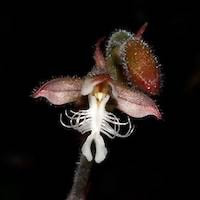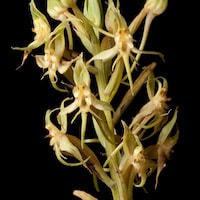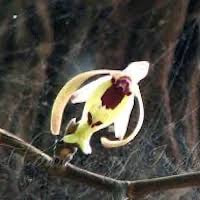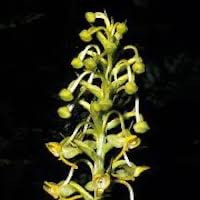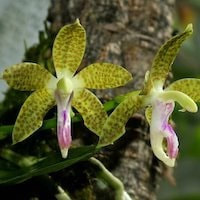WWD6 - Women's Woody 6 - Herb your enthusiasm
|
Native Singaporean Orchid notes: Platanthera Bifolia
Platanthera bifolia, known as Lesser Butterfly Orchid or Nattviole in Scandinavian, Waldhyazinthe in German, and Xijushechun Lan in Chinese, is a fragrant orchid celebrated for its cultural significance and aromatic allure. According to legend, its flowers, resembling angels, emit a strong, pleasant scent that attracts night butterflies like hawk moths. Chemical analysis reveals compounds like lilac alcohols and aldehydes, contributing to its distinctive lilac-like fragrance. Beyond its aroma, it contains loroglossin and phytoalexin, offering potential health benefits and making it a valued ingredient in traditions like the Turkish and Iranian drink Selap.
|
Therapeutic Orchid notes:
|
Anoectochilus reinwardtii Blume
Anoectochilus reinwardtii Blume, commonly called Jewel Orchid, is known for its unique scent and magical associations. Native to Sumatra, Java, Borneo, and Maluku, it thrives at elevations of 1400 to 1700 meters. Among the Iban and Kelabit tribes of Borneo, this orchid is believed to have mystical powers and is used in treating infertility. Local tradition suggests that placing its leaves under a woman's sleeping mat can enhance fertility. While its exact aromatic components remain largely unstudied, its fragrance is integral to these cultural beliefs and practices, highlighting its cultural significance. |
|
Calanthe davidii Franch.
Calanthe davidii Franch., also called Sword Leaf Prawn Spine Orchid or "Jianyexiaji Lan" in Chinese, is prized in Chinese Herbal Medicine for its unique scent and wide applications. It features sword-shaped leaves and prawn spine-like appearance, with flowers growing densely in clusters across its range from India to southern China, Taiwan, and Japan. Endangered in the Himalayas, it shares the medicinal name "Mayaqi" with Calanthe alpina, used interchangeably for health benefits in various herbal remedies. Despite its cultural significance, scientific studies on its fragrance are limited, necessitating further research into its aromatic properties and medicinal potential. |
|
Habenaria stenopetala Lindl.
Habenaria stenopetala Lindl., known as Xiabanyufenghua in Chinese, is a terrestrial herb that blooms from August to October across regions like Thailand, China, and India, thriving in open areas and forests up to 1800 meters high. In Chinese traditional medicine (CTM), it's called Jishencao and used to treat conditions such as erectile dysfunction and hernias, believed to boost kidney and sexual functions. While its fragrance specifics are sparse, its medicinal use and wide distribution underscore its importance, warranting further study into its aromatic properties. |
|
Luisia tenuifolia Blume Syn. Luisia birchea Blume
Luisia tenuifolia Blume, also known as Luisia birchea Blume, is a robust orchid found mainly in southern India, thriving above 1500 meters on tree trunks in clusters, including on the Andaman and Nicobar Islands. While its fragrance specifics are not well-documented, it is valued in herbal medicine for its medicinal properties. The entire plant is traditionally pounded and used as an emollient, applied as a poultice for treating conditions like boils, abscesses, and tumors. Its powder mixed with vinegar is also used to address ailments such as kidney disease, scalding, and reproductive issues. Further research is needed to fully understand its aromatic qualities. |
|
Plantanthera edgeworthii (Hook f. ex Collett) RK Gupta syn. Habenaria edgeworthii Lindl., Habenaria acuminata (Twaites) Trimen
Plantanthera edgeworthii, also known as Habenaria edgeworthii, is an orchid species found in the northwest Himalayas and Tamil Nadu's Anamalai Hills, India. In Ayurvedic medicine, it holds great esteem under names like Riddhi, Laksmi, and Vasa. Known for its aphrodisiac properties, its roots are used as a tonic and food, appreciated for their sweet taste. Ayurvedic principles suggest Riddhi balances Vata and Pitta doshas but may aggravate Kapha. It's utilized in treating blood disorders and is a component in Ashtavarga and Swarnabhashma preparations for enhancing milk production and overall health. Despite its medicinal uses, detailed information about its fragrance remains limited and requires further study. |
|
Sedirea subparishii (Z.H. Tsi) Christianson syn. Hygrochilus subparishii Z.H. Tsi
Sedirea subparishii, also known as Hygrochilus subparishii, is a fragrant orchid native to China, named "Duanjingeji Lan" in Chinese and "Zhijialan" in Chinese medicine. It is prized for its sweetish scent, enhancing its appeal among botanical enthusiasts. In Traditional Chinese Medicine (CTM), it is used to counteract body heat and wind, particularly in children with acute brain and nerve ailments. While its fragrance adds to its allure, its medicinal use primarily focuses on its therapeutic properties and chemical constituents, warranting further scientific exploration into its aromatic components and potential applications. |
Other scent note
Scentopia Library Reference ingredient
bamboo- Singapore native plant - Check details at Scentopia's scent library
Download the guided mediation that works best with this Orchid fragrance oil
| women_woody_essential_oil_orchi_00006.mp3 | |
| File Size: | 169755 kb |
| File Type: | mp3 |

